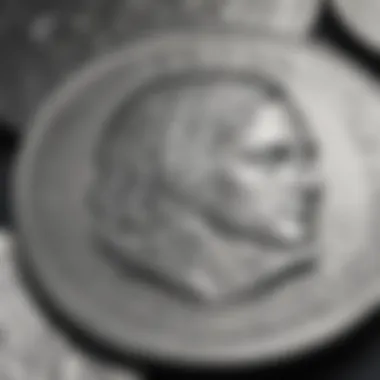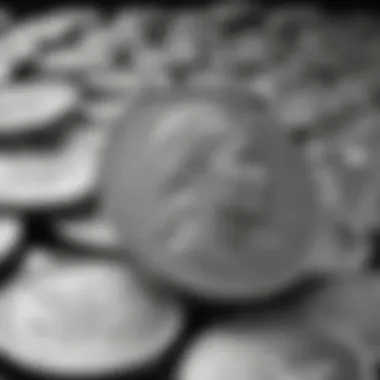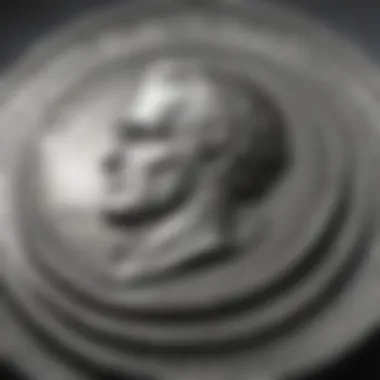Exploring the Silver Dollar Market Today


Intro
Silver dollars hold a special place in both American history and the financial landscape. Their significance stretches from their use in everyday trade to their status as coveted collectibles and investments today. As the market for silver dollars evolves, understanding its current state becomes crucial for investors and collectors alike. The price movements, historical context, and various types of silver dollars can affect decisions in tangible ways. For those looking to maneuver through this complex terrain, gaining insights into terminology, strategies, and product comparisons can enhance the overall investment experience.
Investment Terminology and Concepts
Understanding the lingo is half the battle. When diving into the silver dollar market, familiarizing oneself with the key terms and concepts can save time and potentially lead to better decisions.
Key Terms Explained
- Grading: This refers to the assessment of a coin's quality, which can range from poor to gem uncirculated. Each grade impacts the coin's value.
- Numismatic Value: Beyond the intrinsic value of silver content, this reflects what collectors are willing to pay for rarity and quality.
- Market Sentiment: This term captures the overall feeling among investors. Are people optimistic or pessimistic? This can greatly sway prices.
- Spot Price: The current market price for immediate delivery of silver. It’s important to monitor this, as it directly influences the resale value of silver dollars.
Investment Strategies Overview
When it comes to investing, strategies vary widely. Some investors prefer a hands-on approach, while others opt for passive methods. Here are a few strategies worth considering:
- Long-Term Holding: Buy and hold silver dollars, waiting for market conditions to favor a higher selling price in the future.
- Inventory Rotation: Regularly buying and selling silver dollars based on market fluctuations. Keeping an eye on trends can maximize profits.
- Diversification: Incorporating silver dollars into a broader investment portfolio can mitigate risk, balancing fluctuations in value against more stable assets.
"Investing in silver dollars is more than just about the metal itself; it’s also about understanding the market, the coins, and their historical context."
Familiarizing yourself with these concepts can lay a solid foundation for navigating the silver dollar market more effectively. Knowledge is, after all, the best investment.
Product Reviews and Comparisons
In today's interconnected world, deciding where to invest can feel like drinking from a fire hose. With numerous products and platforms available, solid comparisons can clarify the choice.
In-Depth Financial Product Analysis
Researching different investment options available is essential. For example, if you’re leaning towards physical silver dollars versus silver ETFs, here are some factors to consider:
- Liquidity: How easily can you convert your investment back into cash? Silver ETFs generally offer higher liquidity compared to physical coins.
- Storage: Physical silver requires space and security measures, whereas ETFs are managed electronically.
- Cost: The immediate purchase price is crucial. Buying coins typically involves premiums over the spot price that vary by seller.
Side-by-Side Comparisons
Consider evaluating different types of silver dollars to see which align with your goals. Here are two famous examples:
- Morgan Silver Dollar: Known for its attractive design and rich history, these are highly sought after by collectors.
- Peace Silver Dollar: Created post-World War I, Peace Dollars celebrate peace and harmony.
- Pros: Strong numismatic value.
- Cons: Prices can vary significantly based on condition and demand.
- Pros: Less common than Morgan coins, potential for appreciation.
- Cons: Slightly less popular among collectors, which could affect liquidity.
Each type of silver dollar has its unique characteristics and market dynamics. Understanding these elements can lead to informed investment choices and better results.
By unraveling both the terminology and available products, investors can navigate the silver dollar market with greater confidence and expertise.
Prologue to Silver Dollars
Silver dollars, once widely circulated as everyday currency, have evolved into sought-after collectibles. Understanding this market is crucial for investors and enthusiasts alike. These coins not only hold historical value but also offer insights into economic trends. This article aims to guide you through the fascinating aspects of silver dollars, enhancing your comprehension of their significance in today’s financial landscape.
Historical Overview
Silver dollars have a rich legacy, tracing back to the late 18th century. The introduction of the Continental Congress’ Currency Act in 1785 established the silver dollar as a legal tender. The Morgan Silver Dollar, minted from 1878 to 1904 and then again in 1921, is perhaps one of the most celebrated examples. These coins were crafted during a period marked by rapid industrialization and westward expansion in the United States, reflecting the nation’s growth.
The story of these coins isn’t just about metal and minting. It dives into the U.S. economic policies, currency standards, and the acceptance of silver in various markets. During the Great Depression, the government moved to eliminate silver content in coins, a decision that altered the fate of silver dollars significantly. Investors keen on historical context will find that each coin tells a tale of its era.
Cultural Significance


Silver dollars represent more than mere currency; they symbolize an era, infusing culture with nostalgia. They pop up in American folklore and literature, often signifying wealth or luck. Think about the famed phrase "hard cash"— it’s tangible, it’s solid, and it connects deeply to these coins. They weave into the fabric of local traditions, like the tales of wishing wells where people toss silver dollars for good fortune.
Moreover, the unique designs, like the iconic Liberty and Peace designs, offer a glimpse into the artistic movements of their time. Such coins have ignited passions among collectors, leading to vast communities where enthusiasts discuss rarity, condition, and stories behind their prized possessions. The emotional tie a collector has to their series isn’t just about the coin itself but the history and culture encapsulated in its creation.
In a world driven increasingly by digital currency, silver dollars remain a tangible connection to America's fiscal past, resonating with those who appreciate coins not just as collectibles but as artifacts of history.
Types of Silver Dollars Today
In today's market, the variety of silver dollars is vast and plays a crucial role in both collecting and investment. This section brings to light essential types of silver dollars, illustrating their significance in the wider context of the silver dollar market.
Each silver dollar variant carries its unique story and value proposition, making them not just currency but also pieces of history. For investors and collectors alike, understanding these types can mean the difference between a wise investment and a missed opportunity.
Morgan Silver Dollar
The Morgan Silver Dollar is perhaps the most recognized and celebrated of all silver dollar types. Struck from 1878 to 1904 and again in 1921, it captures a distinct moment in American history. The coin features the famous portrait of Lady Liberty and an eagle on the reverse, embodying the spirit of the time.
The significance of the Morgan Silver Dollar extends beyond its aesthetic appeal. It holds an important place among coin investors due to its relatively high silver content and historical prevalence. Many collectors are fond of it not only for investment purposes but also for its craftsmanship that has stood the test of time. The fact remains that grades, mint marks, and historical issuance significantly influence its market value today.
Peace Silver Dollar
Following the Morgan, the Peace Silver Dollar was introduced as a symbol of hope and prosperity after World War I. Minted from 1921 to 1935, this coin represents a shift in the American psyche, picturing a strong representation of peace with a bold design of Lady Liberty along with a majestic eagle perched on a rock.
Investors often see the Peace Silver Dollar as a bridge between the historical and the modern. As a result, they tend to search out high-grade examples which can command considerable sums in auctions. Its relatively brief minting period adds to its allure, resulting in an actively traded market that appreciates unique pieces and their desirability.
Modern Silver Dollars
Modern silver dollars differ significantly from their historical counterparts. Minted primarily since 1986, the American Silver Eagle is a prime example, combining investment-grade silver with modern minting techniques. Its designs pay homage to earlier coins while reflecting a contemporary style that appeals to current collectors.
Investing in modern silver dollars often consists of focusing on bullion coins that contain an ounce or more of pure silver. These coins are typically linked closely to the spot market for silver, thus making them a popular choice for those who want direct exposure to precious metals. Moreover, factors such as mintage figures and demand can create a vibrant market for modern coins, further enhancing their appeal to investors.
"Understanding the distinctions between various types of silver dollars can illuminate the path to wiser investing."
In summary, each type of silver dollar—not just the more popular ones like the Morgan and Peace—contributes an essential layer of value and interest in the current market. For those looking to navigate through investments wisely, appreciating these types and their unique histories can pave the way for a more rewarding collecting experience.
Current Market Trends
The silver dollar market today reflects a dynamic interplay of various factors. Understanding these trends is crucial for investors looking to navigate this unique market effectively. With fluctuating economic conditions, the demand and supply dynamics of silver dollars can vary significantly, highlighting the importance of staying informed about market movements.
Market Demand and Supply
When considering the demand for silver dollars, one must look at both the collectors' market and the investment community. Historically, silver dollars are known not only for their intrinsic metal value but also for their numismatic appeal. A diverse range of collectors—ranging from casual hobbyists to serious investors—fuels this demand.
- Collector Interest: The rarity and historical significance of certain silver dollars, such as the Morgan and Peace dollars, can drive higher prices at auctions. It is not unusual for a well-preserved specimen to be snagged up quickly when it comes up for sale.
- Investment Demand: A noticeable trend is the increasing interest in silver as a hedge against inflation. Investors are keen on tangible assets, which has led to a growing demand for silver coins in recent years. When paper currencies seem to lose steam, tangible assets like silver dollars become attractive.
On the supply side, the availability of silver dollars can impact market prices significantly. If a large batch of rare coins hits the market, it may soften prices temporarily. Conversely, if supply is limited, enthusiastic buyers may push prices up further.
"In collectibles, scarcity often drives value more than the material itself."
Influences of Economic Factors
Economic pressures can sway both demand and supply in the silver dollar market. A few key influences to consider:
- Inflation Rates: As inflation rises, the appeal of precious metals typically increases. Investors tend to flock toward silver dollars, viewing them as a stable store of value. The correlation between economic instability and rising silver prices should not be underestimated.
- Political Climate: Uncertainty in political landscapes can motivate people to invest in assets that offer more security. For instance, changes in tax regulations affecting capital gains can influence how people approach collecting and investing in silver dollars.
- Global Market Trends: Finally, trends in the global market can also sway local demand. Events such as trade agreements or tariffs can shift the dynamics of both supply chains and consumer demand. With the rise in e-commerce, buyers now have access to a broader marketplace than ever before, impacting both local dealers and online platforms alike.
In essence, keeping an eye on these economic indicators helps investors make informed decisions about entering or exiting the silver dollar market. Understanding the correlation between these economic factors and the trading of silver dollars is essential for making sound investment choices.
Investment Value of Silver Dollars
The investment landscape can be as turbulent as a stormy sea, with silver dollars often viewed as a safe harbor during economic uncertainty. Silver dollars carry particular allure due to their historical significance, intrinsic value, and potential for appreciation. In this section, we will explore how these factors contribute to the investment value of silver dollars and the essential considerations for both novice and seasoned investors.


Historical Pricing Trends
To fully grasp the investment value of silver dollars, it's crucial to examine historical pricing trends. Over the years, silver dollars like the Morgan and Peace varieties have experienced fluctuating prices influenced by market demand, the economy, and geopolitical conditions. For instance, the prices shot up during times of crisis, particularly during the 1970s when inflation was at a peak. This historical perspective allows investors to see how these currencies behave under various economic scenarios.
In more recent decades, the price trends have been shaped by economic recovery from the 2008 financial crisis and increased interest in precious metals as hedges against inflation. The rise of online trading platforms has also made it easier for investors to engage with silver dollars, thus raising their profile in the investment community.
Factors Impacting Value Today
What influences the current value of silver dollars? There are numerous factors at play:
- Market Demand: As interest in precious metals grows, so does the demand for silver dollars. This heightened demand can drive prices upward, making them a lucrative investment option.
- Silver Prices: Silver’s spot price directly affects the intrinsic value of silver dollars. When the price of silver rises, so does the value of the silver coins themselves.
- Scarcity and Rarity: The condition of the coins and their rarity play a critical role as well. Certain rare mintages or high-quality examples can fetch prices well beyond their intrinsic silver value.
- Economic Indicators: Broader economic indicators such as inflation rates, interest rates, and global financial crises can have immediate impacts on investor sentiment, influencing silver dollar values.
Pros and Cons of Investing
Investing in silver dollars can offer unique gains but also comes with its share of challenges. Here’s a rundown of the pros and cons:
Pros:
- Hedge Against Inflation: As a tangible asset, silver dollars can protect wealth during inflationary periods.
- Historical Value: They are not only currency but pieces of history, appealing to both collectors and investors.
- Liquidity: In times of economic uncertainty, silver dollars can easily be bought and sold, providing liquidity.
Cons:
- Market Volatility: Like all commodities, silver can experience wild fluctuations, making timing crucial for investors.
- Storage Concerns: Physical coins require secure storage solutions, which can add another layer of complexity and cost.
- Expertise Required: Navigating the coin market takes knowledge about grading and valuation, making it essential to do proper research or consult with professionals.
Investing in silver dollars is much like navigating the open sea; while it can lead to profitable destinations, one must also be prepared for unexpected tides.
Grading and Valuation
Understanding the grading and valuation of silver dollars is essential for both collectors and investors in today's market. Coin grading is the process of certifying the condition of a coin, which can have a significant impact on its value. High-quality coins may fetch premiums, while lower-grade examples might struggle to retain their worth. For investors, knowing how to assess a coin's grade can lead to strategic buying and selling decisions that maximize returns.
The practice of grading does more than just provide an industry-standard for assessing a coin's worth. It fosters trust among buyers and sellers, as agreements can be made based on established criteria. If collectors can accurately gauge the condition of a coin, they are better equipped to negotiate and make informed decisions.
Understanding Coin Grading Systems
Coin grading systems are structured methodologies used to evaluate a coin's state. The most recognized system is the Sheldon Scale, which ranges from 1 to 70. Here’s a breakdown of this scale:
- 1 to 4: Poor to Fair - identifies coins that may be barely recognizable, suffering from heavy wear.
- 5 to 12: About Good to Good - these coins may display significant wear, losing some detail but remaining identifiable.
- 20 to 35: Fine to Very Fine - showing moderate wear, these coins retain some mint detail.
- 60 to 70: Uncirculated to Perfect - these coins show no signs of wear, and those graded 70 are flawless.
A coin's grade plays a pivotal role in its market demand. Higher grades often mean higher prices, but the rarity and desirability of specific coins must also be considered. For example, a Morgan Silver Dollar in pristine condition will undoubtedly command a price far greater than one that shows heavy wear, even if both might fall into the higher end of the grading scale.
Common Grading Agencies
Several reputable agencies provide grading services for silver dollars, ensuring standardization and professional evaluation of coins. Here are some of the most widely recognized:
- Professional Coin Grading Service (PCGS): One of the leading firms in the industry, PCGS is known for its rigorous grading standards and has a loyal following among serious collectors.
- Numismatic Guaranty Company (NGC): Another major player, NGC provides objective grading and has built a strong reputation over the years.
- American Numismatic Association (ANA): The ANA offers grading services along with educational resources, helping collectors to understand the intricacies of grading.
- Ira & Larry Goldberg Coins & Collectibles: While not a grading agency per se, they offer insights and auctions that can guide collectible grading decisions.
"Understanding the grading and valuation process is crucial. Knowing what you have, and its worth, gives you the savvy to navigate the market effectively."
Collecting Silver Dollars
Collecting silver dollars is more than a hobby; it's an investment, a nostalgia trip, and a step into the pages of American history. Silver dollars often hold a sentimental value that exceeds their mere metallic worth. They're a tangible reminder of eras gone by and a glimpse into the economic factors that have shaped our society. As more investors look toward alternatives for securing assets, silver dollars present an intriguing opportunity not just for collecting but as a prudent investment option. Let's unpack a bit about this fascinating pursuit and its significance.
When it comes to starting a collection, several elements come into play. First off, understanding what you enjoy, what resonates with you, becomes vital. Maybe it’s the historical context of the Morgan Silver Dollar, tracing back to 1878, or perhaps the more modern and whimsical designs reflecting the spirit of recent generations. Knowing which subset of this broad category excites you will steer your collection and keep you engaged over time.
There are numerous benefits to collecting silver dollars, including:
- Financial Security: In times of economic uncertainty, silver often maintains its value, making these coins a safer asset compared to cash, which might lose purchasing power.
- Historical Insight: Each type of silver dollar, from the Morgan to the Peace dollar, offers stories that reflect the cultural and economic narratives of their time.
- Community & Networking: Joining the ranks of fellow collectors helps build relationships with others who share your interest, offering avenues for knowledge exchange and trading opportunities.
Yet, along with the thrill and benefits, potential collectors need to keep some considerations in mind. As with any investment, it is crucial to navigate the waters wisely. Knowing the right storage practices, the importance of grading, and avoiding counterfeit coins can make or break a collection. It’s not all sunshine and rainbows, but with diligence, the merits can far outweigh the pitfalls.


"The allure of silver dollars lies not just in their past, but in their potential for future value, intertwining stories, and the thrill of the hunt."
Starting a Collection
To embark on your journey of collecting silver dollars, you might want to consider where to start. Establishing a foundation will guide your way as you navigate the market's ebb and flow. Begin by defining the types you want to collect. Themes can vary: perhaps you want to focus on a specific era, such as the 19th century, or on coins that have been minted within the last few decades. Also, consider the condition of the coins—you can choose between uncirculated, circulated, or graded pieces.
Research is another essential step. Familiarizing yourself with key resources like books, online forums, or even the coin catalog on Wikipedia can provide invaluable insight. Additionally, attending local coin shows or joining clubs can widen your understanding and expose you to various facets of numismatics.
A practical approach can also be checking online marketplaces like Reddit's coin communities or Facebook groups for reliable recommendations on what to purchase and where.
Finding Reputable Dealers
Finding a trustworthy dealer can feel like navigating a minefield, especially for newcomers. The credibility of the source is paramount; buying from the wrong person could lead to purchasing counterfeit or overvalued coins. So, how do you sift through the noise?
- Check Credentials: Look for dealers who belong to national organizations, such as the American Numismatic Association. Membership can signify adherence to a code of ethics.
- Online Reviews: Utilize resources like Britannica or community reviews on platforms like Facebook or Reddit to gauge dealer reputation.
- Ask Questions: Don’t hesitate to engage with potential dealers. Ask about their grading practices, return policies, or how they source their inventory. A reputable dealer will willingly provide clear answers and guarantees.
Remember, the fundamental rule is to trust your instincts. If something feels off during a transaction, it’s often best to walk away. In the world of collecting silver dollars, being informed and cautious can lead to rewards and joys that far exceed initial expectations.
Storage and Protection
In the realm of silver dollars, particularly for collectors and investors, storage and protection are essential elements that cannot be overlooked. When one considers the potential value of these coins, which can fluctuate based on market trends and varying demand, ensuring their safety is paramount. Investing in silver dollars isn’t just about acquisition; it's also about preservation. A vigilant approach to storing these coins safeguards against both physical harm and diminished value over time.
Best Practices for Storing Silver Dollars
Storing silver dollars might seem straightforward, but there are key practices that can make all the difference in your collection's longevity. Here are some suggestions to consider:
- Use Coin Holders: Opt for acid-free holders or coin flips. These materials prevent tarnishing and corrosion while keeping the coins visible and accessible.
- Cool, Dry Environment: Find a spot to store your coins that’s free from humidity and extreme temperatures. A consistent environment is best, avoiding places like attics or basements that might fluctuate.
- Avoid Handling: Always handle coins by their edges and keep them in their holders as much as possible. Fingerprints and oils can cause long-term damage.
- Secure Location: Keep your collection in a lockbox or safe. Consider a fireproof option to guard against disasters.
- Inventory Keeping: Maintain a well-documented inventory of your collection, noting condition, purchase price, and current market value. This helps in insurance evaluations and future sales.
These practices can significantly bolster the preservation of silver dollars, showcasing your commitment to your collection and investment.
Insurance Considerations
When one invests in silver dollars, the thoughtful decision to insure the collection can provide peace of mind. Here are a few factors that you might want to delve into:
- Extent of Coverage: Ensure that your policy covers the full value of the collection, keeping in mind that coin values can shift with market conditions.
- Rider Policies: Look into specialized insurance riders that cater specifically to collectibles. This often includes theft, loss, or damage in various scenarios.
- Professional Appraisals: Regular appraisals can help your insurance remain relevant. Market evaluations can provide updated values that reflect the current climate.
- Storage Clauses: Some policies may have specific stipulations concerning how collectibles are stored. A safe or a safety deposit box usually meets these requirements.
"Protecting your investment is as important as the investment itself."
Insuring your silver dollars is not merely a precaution; it's a strategic approach for securing potential financial returns down the line.
Taking these measures into account will not only shield your investment from unforeseen circumstances but also add another layer of confidence as you navigate the intricacies of the silver dollar market.
Future Prospects for Silver Dollars
As we consider the future of silver dollars, it's essential to grasp how the current market dynamics could play out in the coming years. The silver dollar isn't just a relic of history; it remains a significant player in both coin collecting and investment arenas. Understanding where this market might be headed can provide investors and collectors with an informed edge.
Market Predictions
Looking ahead, several factors come into play regarding the future value of silver dollars. The demand tends to rise with increasing interest in precious metals, particularly during economic uncertainty. Investors may flock to tangible assets like silver dollars when stock markets wobble. For example, in the wake of economic downturns, we've observed spikes in demand for these coins, primarily due to their intrinsic value.
Additionally, silver supply dynamics significantly influence market pricing. Mining outputs fluctuate, often tied to global economic health. Investors keeping tabs on mining sector news can gain insights into potential supply shortages or surpluses. If production dips and demand stays robust, prices might experience upward pressure.
- Market Sentiment: The attitude of investors can sway pricing. If positive sentiment prevails, enthusiasm can drive up prices.
- Geopolitical Factors: Political tensions often lead to uncertainty in the markets. In such times, silver can serve as a safe haven, pushing prices higher.
Emerging Trends
Recognizing emerging trends can be crucial in navigating the contemporary silver dollar landscape. One noteworthy trend is the rise of technology in coin trading. Numerous platforms now allow collectors and investors to buy and sell silver dollars seamlessly online. This development opens the door for a wider audience and potentially enhances liquidity in the market.
Another trend is the growing interest in graded silver coins. As more collectors realize the importance of certification, the demand for high-quality, professionally graded silver dollars has surged. Investors are showing a preference for coins with well-documented histories and prove quality, which often translates to higher resale values.
Some other trends to watch:
- Diversification in Investing: Savvy investors now blend silver dollars into their portfolios alongside stocks and real estate.
- Sustainability Concerns: As awareness of sustainable practices grows, eco-friendly mining techniques may influence buyer perception and market behavior.
In summary, the future of silver dollars rests upon a mesh of supply-demand dynamics, modern trends in trading, and investment habits. Adjusting focus to these elements can aid both seasoned investors and newcomers alike in making informed decisions that will shape their collecting and investing strategies.



